Table of Contents
Is Matter Around Us Pure Class 9 Extra Questions Science Chapter 2
Extra Questions for Class 9 Science Chapter 2 Is Matter Around Us Pure
Is Matter Around Us Pure Class 9 Extra Questions Very Short Answer Questions
Question 1.
How can you change a saturated solution to an unsaturated solution without adding any more solvent to it?
Answer:
By heating the saturated solution, it becomes unsaturated.
Question 2.
Sucrose (sugar) crystals obtained from sugarcane and beetroot are mixed together. Will it be a pure substance or a mixture? Give reasons for the same. [NCERT Exemplar]
Answer:
It is a pure substance because chemical composition of sugar crystals is same irrespective of its source.
Question 3.
Based on which factor a solution is said to be diluted, concentrated or saturated?
Answer:
A solution is said to be diluted, concentrated or saturated on the basis of the amount of solute dissolved in the solution.
Question 4.
Identify solute and solvent in ‘tincture of iodine’.
Answer:
Iodine is the solute and alcohol is the solvent.
Question 5.
What is mass per cent of a solution?
Answer:
It is defined as the mass in grams of the solute present in one hundred grams of a solution.
Question 6.
What are the two components of a colloidal solution?
Answer:
The two components of a colloidal solution are dispersed phase and dispersing medium.
Question 7.
In what respect does a true solution differ from a colloidal solution?
Answer:
A true solution is homogeneous whereas a colloidal solution is heterogeneous.
Question 8.
Two liquids ‘A’ and ‘B’ are miscible with each other at room temperature. Which separation technique will you apply to separate the mixture of ‘A’ and ‘B’ if the difference in their boiling points is 27°C?
Answer:
We can separate two miscible liquids by fractional distillation, if both the liquids have difference in their boiling points. So, the mixture of liquids ‘A’ and ‘B’ can be separated by fractional distillation.
Question 9.
Define crystallisation.
Answer:
It is a process that separates a pure solid in the form of its crystals from a solution.
Question 10.
Why is crystallisation technique considered better than simple evaporation to purify solids?
Answer:
Crystallisation is considered better than simple evaporation because
- some solids decompose or get charred on heating to dryness.
- some impurities may remain dissolved in the solution even after filtration. On evaporation, these contaminate the solid.
Question 11.
Why is water called universal solvent?
Answer:
Water is known as universal solvent because it has the ability to dissolve wide variety of substances.
Question 12.
Which of the following are physical changes?
Melting of iron metal, rusting of iron, bending of iron rod, drawing a wire of iron metal.
Answer:
Melting of iron metal, bending of iron rod and drawing a wire of iron metal are physical changes because there is no change in the chemical composition of iron, only its form is changing.
Question 13.
Name two elements which exist in liquid state at room temperature.
Answer:
Gallium and mercury exist in liquid state at room temperature.
Question 14.
An unknown substance ‘A’ on thermal decomposition produces ‘B’ and ‘C’. What is ‘A’—an element, a compound or a mixture?
Answer:
Unknown substance ‘A’ should be a compound because elements and mixture do not decompose.
Question 15.
Identify the elements from the following substances: sulphur, brine, hydrochloric acid, water, neon, paper, sugar.
Answer:
The elements are sulphur and neon.
Is Matter Around Us Pure Class 9 Extra Questions Short Answer Questions-I
Question 1.
‘Sea water can be classified as homogeneous as well as heterogeneous mixture.’ Comment. [NCERT Exemplar]
Answer:
Sea water is a mixture of salts and water which cannot be separated except by evaporation. Therefore, sea water is considered homogeneous.
Sea water also contains mud, decayed plant, etc., other than salts and water, so it is heterogeneous also.
Question 2.
Why is it not possible to distinguish particles of a solute from the solvent in solution?
Answer:
A true solution is homogeneous in nature. The solute and solvent particles are very small. They cannot be distinguished even under a microscope.
Question 3.
Explain why particles of a colloidal solution do not settle down when left undisturbed, while in the case of a suspension they do. [NCERT Exemplar]
Answer:
Particle size in a suspension is larger than those in a colloidal solution. Also molecular interaction in a suspension is not strong enough to keep the particles suspended and hence they settle down.
Question 4.
Identify colloids and true solutions from the following:
Pond water, fog, aluminium paint, vinegar and glucose solution.
Answer:
True solutions are vinegar and glucose solution. Colloids are fog, aluminium paint.
Question 5.
Give two examples each for
- Aerosol,
- Emulsion.
Answer:
- Aerosol: Clouds, smoke
- Emulsion: Milk, face cream.
Question 6.
Smoke and fog both are aerosols. In what way are they different? [NCERT Exemplar]
Answer:
Both fog and smoke have gas as the dispersion medium. The only difference is that the dispersed phase in fog is liquid and in smoke it is a solid.
Question 7.
What do you understand by the term distillation? Give its one application.
Answer:
Distillation is a process of boiling a liquid and then condensing the vapour obtained into a liquid. This process is used to obtain wines from the sugarcane juice.
Question 8.
While diluting a solution of salt in water, a student by mistake added acetone (boiling point 56°C). What technique can be employed to get back the acetone? Justify your choice. [NCERTExemplar]
Answer:
Distillation is used to get back acetone. We know that boiling point of water is 100°C and since acetone is more volatile it will separate out first.
Question 9.
Define chromatography and give its one application.
Answer:
Chromatography is a technique used for the separation of a mixture of solutes brought about by distribution of dissolved material between two immiscible phases, one of which is mobile phase and the other part is stationary phase. It is useful in forensic science to detect and identify trace amounts of substances in the contents of bladder or stomach.
Question 10.
Rain water stored in a tank contains sand grains, unfiltrable clay particles, calcium carbonate, salt, pieces of paper and some air bubbles. Select from amongst these one example each of a solvent, a solute, a colloid and a suspension.
Answer:
Solvent – water Solute – salt
Colloid – air bubbles Suspension – clay particles.
Question 11.
Classify the following as physical or chemical properties:
(a) The composition of a sample of steel is 98% iron, 1.5% carbon and 0.5% other elements.
(b) Zinc dissolves in hydrochloric acid with the evolution of hydrogen gas.
(c) Metallic sodium is soft enough to be cut with a knife.
(d) Most metal oxides form alkalis on interacting with water. [NCERT Exemplar]
Answer:
Physical properties—(a) and (c)
Chemical properties—(b) and (d)
Question 12.
Give two points of differences between an element and a compound.
Answer:
| Element | Compound |
| 1. An element is made up of same kind of atoms. | 1. A compound is obtained from different kinds of atoms. |
| 2. An element cannot be split by physical or chemical methods. | 2. A compound can be split into new substances by chemical methods. |
Question 13.
Which of the following are not compounds?
(a) Chlorine gas
(b) Potassium chloride
(c) Iron
(d) Iron sulphide
(e) Aluminium
(f) Iodine
(g) Carbon
(h) Carbon monoxide
(i) Sulphur powder
Answer:
Chlorine gas, iron, aluminium, iodine, carbon, sulphur powder.
Question 14.
Is water an element or a compound? Give reason in support of your statement
Answer:
Water is a compound because of the following reasons:
- It is composed of two different elements, hydrogen and oxygen which cannot be separated by physical methods. They can be separated only by electrolysis.
- The physical and chemical properties of hydrogen and oxygen are entirely different from the properties of water.
Is Matter Around Us Pure Class 9 Extra Questions Short Answer Questions-II
Question 1.
Identify the dispersed phase and dispersing medium in the following colloids.
(a) Fog
(b) Cheese
(c) Coloured gemstone
Answer:
(a) Fog—liquid, gas
(b) Cheese—liquid, solid
(c) Coloured gemstone—solid, solid
Question 2.
Describe any three properties of colloid.
Answer:
- It is a heterogenous mixture.
- Size of particles is too small to be seen by naked eye.
- They scatter light passing through them making its path visible.
- They do not settle down when left undisturbed.
- They cannot be separated by the process of filtration, (any three points)
Question 3.
State the principle of separating two immiscible liquids by separating funnel. Describe an activity with diagram to separate a mixture of water and kerosene oil.
Answer:
Immiscible layers separate out in layers depending on their densities in separating funnel.
Activity to separate kerosene oil from water using a separating funnel:
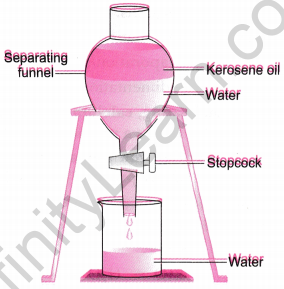
- Pour the mixture of kerosene oil and water in separating funnel as shown in figure.
- Let it stand undisturbed for sometime so that separate layers of oil and water are formed.
- Open the stopcock of the separating funnel and pour out the lower layer of water carefully.
- Close the stopcock of the separating funnel as the oil reaches the stopcock.
Question 4.
What would you observe when
(a) a saturated solution of potassium chloride prepared at 60°C is allowed to cool at room temperature?
(b) an aqueous sugar solution is heated to dryness?
(c) a mixture of iron filings and sulphur powder is heated strongly? [NCERT Exemplar]
Answer:
(a) Solid potassium chloride will separate out.
(b) Initially the water will evaporate and then sugar will get charred.
(c) Iron sulphide will be formed.
Question 5.
Suggest separation technique (s) one would need to employ to separate the following mixtures:
(a) Mercury and water
(b) Potassium chloride and ammonium chloride
(c) Common salt, water and sand
(d) Kerosene oil, water and salt. [NCERT Exemplar]
Answer:
(a) Separation by using separating funnel
(b) Sublimation
(c) Filtration to separate sand followed by evaporation/distillation
(d) Separation by using separating funnel to separate kerosene oil followed by evaporation or distillation.
Question 6.
Name the process associated with the following:
(a) Dry ice is kept at room temperature and at one atmospheric pressure.
(b) A potassium permanganate crystal is in a beaker and water is poured into the beaker with stirring.
(c) An acetone bottle is left open and the bottle becomes empty.
(d) Milk is churned to separate cream from it.
(e) Settling of sand when a mixture of sand and water is left undisturbed for some time.
(f) Fine beam of light entering through a small hole in a dark room, illuminates the particles in its paths. [NCERT Exemplar]
Answer:
(a) Sublimation
(b) Dissolution/diffusion
(c) Evaporation/diffusion
(d) Centrifugation
(e) Sedimentation
(f) Scattering of light (Tyndall effect).
Question 7.
On heating, calcium carbonate gets converted into calcium oxide and carbon dioxide.
(a) Is this a physical or a chemical change?
(b) Can you prepare one acidic and one basic solution by using the products formed in the above process? If so, write the chemical equation involved. [NCERT Exemplar]
Answer:
(a) Chemical change.
(b) Acidic and basic solutions can be prepared by dissolving the products of the above process in water.
CaO + H2O → Ca(OH)2 (basic solution)
CO2 + H2O → H2CO3 (acidic solution)
Question 8.
Non-metals are usually poor conductors of heat and electricity. They are non-lustrous, non-sonorous, non-malleable and are coloured.
(a) Name a lustrous non-metal.
(b) Name a non-metal which exists as a liquid at room temperature.
(c) The allotropic form of a non-metal is a good conductor of electricity. Name the allotrope.
(d) Name a non-metal which is known to form the largest number of compounds.
(e) Name a non-metal other than carbon which shows allotropy.
(f) Name a non-metal which is required for combustion. [NCERT Exemplar]
Answer:
(a) Iodine
(b) Bromine
(c) Graphite
(d) Carbon
(e) Sulphur
(f) Oxygen
Question 9.
Classify the following into metals, non-metals and metalloids:
(i) Germanium
(ii) Boron
(iii) Diamond
(iv) Iodine
(v) Copper
(vi) Helium.
Answer:
Metal – Copper
Non-metals – Diamond, iodine and helium
Metalloids – Germanium, boron.
Question 10.
Classify the following into elements, compounds and mixtures.
(i) Pure sand
(ii) Air
(iii) Ammonia gas
(iv) Ice
(v) Glass
(vi) CaO.
Answer:
Elements – Nil
Compounds – Pure sand, Ice, CaO, Ammonia gas
Mixture – Air, Glass.
Is Matter Around Us Pure Class 9 Extra Questions Long Answer Questions
Question 1.
Differentiate between a true solution and a colloid.
Answer:

Question 2.
Distinguish between physical change and chemical change.
Answer:
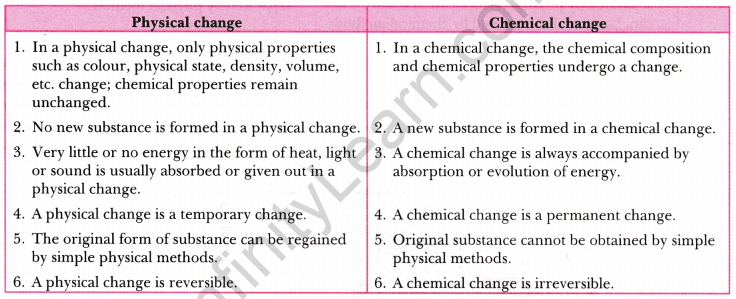
Question 3.
Distinguish between metals and non-metals.
Answer:
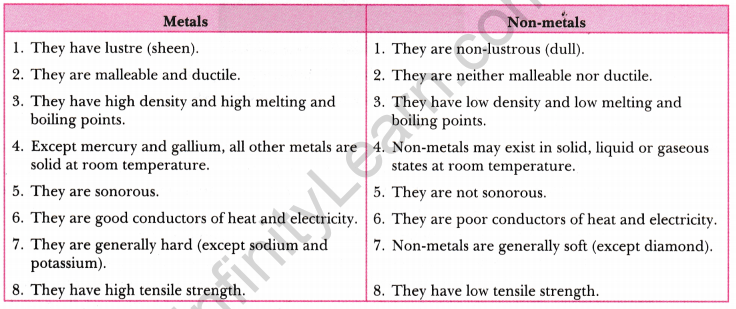
Question 4.
Distinguish between compounds and mixtures.
Answer:
Question 5.
A group of students took an old shoe box and covered it with a black paper from all sides. They fixed a source of light (a torch) at one end of the box by making a hole in it and made another hole on the other side to view the light. They placed a milk sample contained in a beaker/tumbler in the box as shown in the figure. They were amazed to see that milk taken in the tumbler was illuminated. They tried the same activity by taking a salt solution but found that light simply passed through it.
(a) Explain why the milk sample was illuminated. Name the phenomenon involved.
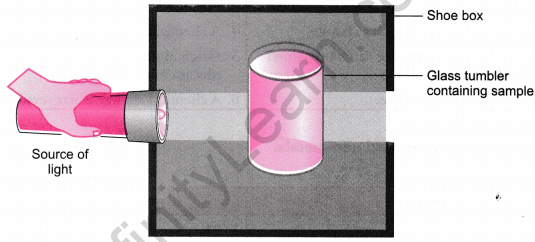
(b) Same results were not observed with a salt solution. Explain.
(c) Can you suggest two more solutions which would show the same effect as shown by the milk solution? [NCERT Exemplar]
Answer:
(a) Milk is a colloid. If a beam of light is put on a milk sample contained in a beaker, the path of light beam is illuminated and becomes visible when seen from the other side. This is because the colloidal particles are big enough to scatter light falling on them. This scattered light enters our eyes and we are able to see the path of light beam.
The scattering of light by colloidal particles is known as Tyndall effect.
(b) Salt solution is a true solution. If a beam of light is put on a salt solution kept in a beaker in a dark room, the path of light beam is not visible inside the solution when seen from the other side. This is because salt particles present in it are so small that they cannot scatter light rays falling on them.
(c) Detergent solution, sulphur solution.
Question 6.
Fractional distillation is suitable for separation of miscible liquids with a boiling point difference of about 25 K or less. What part of fractional distillation apparatus makes it efficient and possess an advantage over a simple distillation process? Explain using a diagram. [NCERT Exemplar]
Answer:
The fractionating column packed with glass beads provides a surface for the vapours to collide and lose energy so that they can be quickly condensed and distilled. Also, length of the column would increase the efficiency of separation.
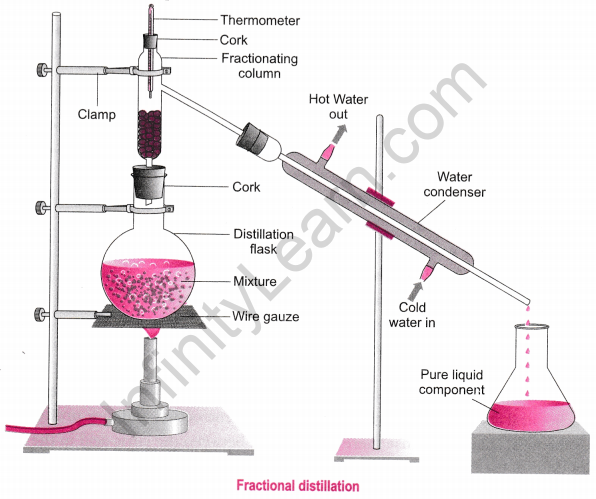
Question 7.
A child wanted to separate the mixture of dyes constituting a sample of ink. He marked a line by the ink on the filter paper and placed the filter paper in a glass containing water as shown in figure. The filter paper was removed when the water moved near the top of the filter paper.
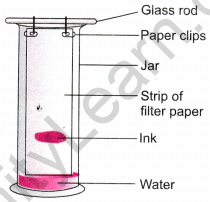
(i) What would you expect to see, if the ink contains three different coloured components?
(ii) Name the technique used by the child.
(iii) Suggest one more application of this technique. [NCERT Exemplar]
Answer:
(i) The colour component which is more soluble in water dissolves first, rises faster and produces a colour band (spot) on the paper at a higher position. The less soluble colour components dissolve a little later, rise slower and form coloured bands at lower heights. In this way, three different bands will be observed.
(ii) Chromatography
(iii) To separate the pigments present in chlorophyll.
Question 8.
You are provided with a mixture containing sand, iron filings, ammonium chloride and sodium chloride. Describe the procedures you would use to separate these constituents from the mixture. [NCERT Exemplar]
Answer:
- Removing iron filings from the mixture by magnetic separation. Take the mixture in a petri dish and roll a bar magnet over it. Iron filings will get attach to the magnet and thus separate from the mixture.
- Removing ammonium chloride by sublimation Transfer the remaining mixture into China dish and heat it. On heating, ammonium chloride sublimes and solidifies on condensation. The mixture containing sand and sodium chloride left behind in the China dish.
- Removing sand by filtration Make a solution of sand and sodium chloride in water. Filter the solution. Sodium chloride will dissolve in water and sand is left as residue on the filter paper.
- Evaporate the filtrate to dryness to get sodium chloride or by crystallisation.
Question 9.
Classify each of the following as a physical or a chemical change. Give reasons.
(a) Drying of a shirt in the sun.
(b) Rising of hot air over a radiator.
(c) Burning of kerosene in a lantern.
(d) Change in the colour of black tea on adding lemon juice to it.
(e) Churning of milk cream to get butter. [NCERT Exemplar]
Answer:
(a) It is a physical change because water is converted from its liquid state to gaseous state because of the sun’s heat.
(b) It is a physical change because water in the radiator is converted from a liquid state to gaseous state.
(c) It is a chemical change because combustion of kerosene occurs and new products are formed.
(d) It is a chemical change because there is a reaction between the citric acid in the lemon and the compounds of tea resulting in formation of new products.
(e) It is a physical change because the cream suspended in the milk is separated by churning.
Question 10.
Show diagrammatically how water is purified in the waterworks system and list the processes involved.
Answer:
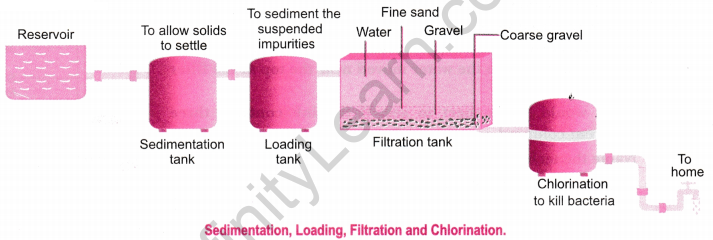
Question 11.
Iron filings and sulphur were mixed together and divided into two parts ‘A’ and ‘S’. Part ‘A’ was heated strongly while Part ‘S’ was not heated. Dilute hydrochloric acid was added to both the parts and evolution of gas was seen in both the cases. How will you identify the gases evolved?
[NCERT Exemplar]
Answer:
Part A
\(\mathrm{Fe}(s)+\mathrm{S}(s) \quad \stackrel{\mathrm{Heat}}{\longrightarrow} \quad \mathrm{FeS}(s)\)
FeS(s) + 2HCl(aq) → FeCl2(aq) + H2S(g)
Part B
Fe(i) + S(s) → Mixture of iron filings and sulphur
When dilute HCl is added to it
Fe(s) + S(s) + 2HCl(aq) → FeCl2(aq) + H2(g)
Sulphur remains unreacted.
H2S gas formed has a foul smell and on passing through lead acetate solution, it turns the solution black. Hydrogen gas burns with a pop sound.
Numericals
Question 1.
0.5 g of salt is dissolved in 25 g of water. Calculate the percentage amount of the salt in the solution.
Solution:
Mass of salt present = 0.5 g
Mass of water present in solution = 25 g
∴ Percentage amount of the salt = \(\frac{0.5}{0.5+25} \times 100\) = 1.96%
Question 2.
A solution of urea in water contains 16 grams of it in 120 grams of solution. Find out the mass percentage of the solution.
Solution:
Mass of urea present in solution = 16 g
Mass of solution = 120 g
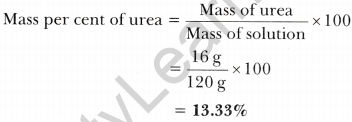
Question 3.
A solution has been prepared by mixing 5.6 mL of alcohol with 75 mL of water. Calculate the percentage (by volume) of alcohol in the solution.
Solution:
Volume of alcohol present in solution = 5.6 mL
Volume of water = 75 mL
Total volume of solution = (75 + 5.6) mL = 80.6 mL

Question 4.
A solution contains 30 g of glucose, 20 g of salt in 500 mL of water. Calculate the mass per cent of
(a) glucose,
(b) salt (density of water = 1 g /mL).
Solution:
Mass of glucose present in the solution = 30 g
Mass of salt present in the solution = 20 g
Mass of water = 500 g
Total mass of the solution = (30 + 20 + 500)g
= 550 g
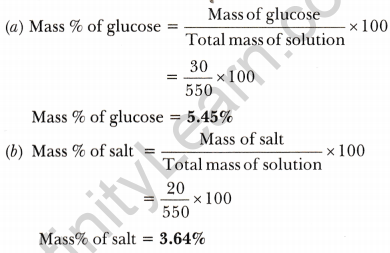
Question 5.
During an experiment the students were asked to prepare a 10% (Mass/Mass) solution of sugar in water. Ramesh dissolved 10 g of sugar in 100 g of water while Sarika prepared it by dissolving 10 g of sugar in water to make 100 g of the solution. [NCERT Exemplar]
(a) Are the two solutions of the same concentration?
(b) Compare the mass % of the two solutions.
Solution:
(a) No.
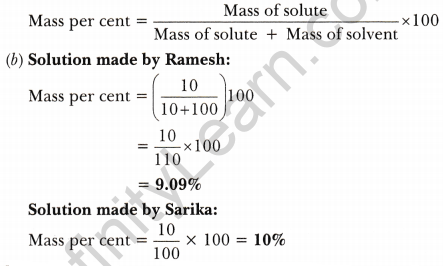
The solution prepared by Sarika has a higher mass per cent than that prepared by Ramesh.
Question 6.
Calculate the mass of sodium sulphate required to prepare its 20% (mass per cent) solution in 100 g of water. [NCERT Exemplar]
Solution:
Let the mass of sodium sulphate required be x g.
The mass of solution would be = (x + 100)g
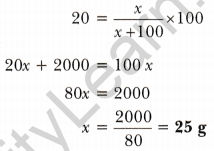
So, the mass of sodium sulphate required is 25 g.
Question 7.
Calculate the mass of water and glucose required to make 250 g of 40% solution of glucose.
Solution:
Mass of solution = 250g

∴ Mass of glucose = \(\frac{40 \times 250}{100}\) = 100g
Mass of solution = Mass of glucose + Mass of water
So, Mass of water = Mass of solution – Mass of glucose
= 250g – 100g = 150g
Question 8.
How much water should be mixed with 12 mL of alcohol so as to obtain 12% alcohol solution?
Solution:
Volume of solute =12 mL
Let the volume of water = x mL
Volume of solution = (12 + x) mL
Concentration of solution = \(\frac{\text { Volume of solute }}{\text { Volume of solution }} \times 100\)
\(12=\frac{12}{12+x} \times 100\)
12 + x = 100
x = 100 – 12 = 88mL
So, 88 mL of water should be mixed.
Is Matter Around Us Pure Class 9 Extra Questions Hots (Higher Order Thinking Skills)
Question 1.
(a) Under which category of mixtures will you classify alloys and why?
(b) A solution is always a liquid. Comment.
(c) Can a solution be heterogeneous? [NCERT Exemplar]
Answer:
(a) Alloys are homogeneous mixture of two or more elements because the constituent elements mix together and give a mixture which is uniform throughout.
(b) No, solid solutions and gaseous solutions are also possible.
Examples are brass, air.
(c) No, a solution cannot be heterogeneous in nature.
Question 2.
The teacher instructed three students A’, ‘B’ and ‘C’ respectively to prepare a 50% (mass by volume) solution of sodium hydroxide (NaOH). ‘A’ dissolved 50 g of NaOH in 100 mL of water, ‘B’ dissolved 50 g of NaOH in 100 g of water while ‘C’ dissolved 50 g of NaOH in water to make 100 mL of solution. Which one of them has made the desired solution and why? [NCERT Exemplar]
Answer:
‘C’ has made the desired solution because 50% (mass by volume) solution means 50g of solute dissolved in 100 mL of solution.
Mass by volume per cent = \(\frac{\text { Mass of solute }}{\text { Volume of solution }} \times 100\)
= \(\frac{50}{100} \times 100\) = 50% mass by volume.
Question 3.
Explain why filter paper cannot be used to separate colloids.
Answer:
The size of colloidal particles is less than lnm, while the size of pores present in an ordinary filter paper is larger than lnm. Hence, a colloidal solution cannot be separated by filtration.
Question 4.
Three students A, B and C prepared mixtures using chalk powder, common salt and milk respectively in water. Whose mixture:
(i) would not leave residue on filter paper after filtration?
(ii) would show Tyndall effect?
(iii) would give transparent/clear solution?
(iv) would settle down at the bottom when left undisturbed?
(v) could be filtered by filter paper?
Answer:
(i)
- Mixture of common salt and water.
- Mixture of milk and water.
(ii) Mixtures of chalk powder with water and milk with water.
(iii) Mixture of common salt and water.
(iv) Mixture of chalk powder and water.
(v) Mixture of chalk powder and water.
Question 5.
Can we separate alcohol dissolved in water by using a separating funnel? If yes, then describe the procedure. If not, explain. [NCERT Exemplar]
Answer:
We cannot separate alcohol dissolved in water by using separating funnel because both the components are highly soluble in each other. They can be separated by fractional distillation.
Question 6.
What is the reason for running cold water through condenser from lower side to upper side in distillation process?
Answer:
In distillation process condensation of vapours take place. To absorb more heat, cold water is passed from lower side so that it will stay for longer time and absorb more heat from the vapours to form liquid state of the substance.
Question 7.
You are given two samples of water labelled as ‘A’ and ‘B’. Sample ‘A’ boils at 100°C and sample ‘B’ boils at 102°C. Which sample of water will not freeze at 0°C? Comment. [ NCERT Exemplar]
Answer:
Sample ‘B’ will not freeze at 0°C because it is not pure water. At 1 atm, the boiling point of pure water is 100°C and the freezing point of pure water is 0°C.









